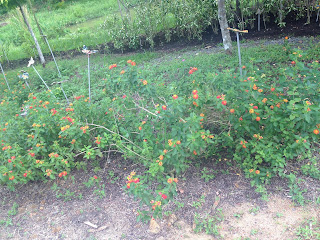Part A: Introduction to Jurong Eco Garden
- Write down a brief introduction to Jurong Eco Garden (JEG)
Jurong Eco Garden is the "green lungs" of CleanTech Park. It is a place of respite for the working community within the business park, the residential community in the vicinity and the natural wildlife that make up the unique ecology of the site. It has four areas called the Summit Forest, Wildlife Corridor, Stream Ravine and Freshwater Swamp Forest. JEG is home to more than 139 species of flora and fauna, out of which six are considered species of conservation interest.
- Include group reflection.
We had a fun time visiting the Jurong eco garden. We got to see many different types of plants, animals and insects that we do not see very often. We got to know about many interesting facts and information about the living things we saw there.
Part B: Grouping and naming organisms
- Upload the most interesting photos/sketches that you have and try to identify them ( eg. species of plant, or bird )
Name: Malayan Banyan Tree
Scientific Name: Ficus Microcarpa
Fact: Being dispersed efficiently by birds the Malayan Banyan can be found growing on trees, from cracks of buildings or drains, or just individually as a tree.
Name: Ixora Plant
Scientific Name: Ixora Coccinea
Fact: There are more than 500 species of Ixora and numerous varieties, and some have been used
as part of traditional medicine, while others have a tendency to have invasive roots.
Name: Lantana Plant
Scientific Name: Lantana Camara
Fact: From pale colors to the more bold colors.
Name: Crepe Ginger
Scientific Name: Cheilocostus speciosus
Fact: The plant has many historical uses in Ayurveda, where the rhizome has been used to treat fever,rash and asthma.
Name: Snail
Scientific Name: achatinoidea
Fact: Snails’ ancestors are one of the earliest known types of animals in the world.
Scientific name: Geopelia striata
Fact: Feeds on small grass and weed seeds, as well as insects and other small invertebrates. It also Readily Eats Bread Products.
Name: millipede
Scientific Name: Diplopoda
Fact:When they hatch, millipedes only have 3 pairs of legs.
Part C: Impact of man on Biodiversity

Part D:
Part E: Credits and Acknowledgement.
Scientific Name: Lantana Camara
Fact: From pale colors to the more bold colors.
The intensity of the colors of the Lantana can change as the flower matures as well.
Scientific Name: Cheilocostus speciosus
Fact: The plant has many historical uses in Ayurveda, where the rhizome has been used to treat fever,rash and asthma.
Name: Snail
Scientific Name: achatinoidea
Fact: Snails’ ancestors are one of the earliest known types of animals in the world.
Name: Common Birdwing butterfly
Scientific Name: Ornithoptera richmondia
Fact:The common birdwing is amongst the largest and most beautiful butterflies in Asia.
Name: Zebra DoveScientific name: Geopelia striata
Fact: Feeds on small grass and weed seeds, as well as insects and other small invertebrates. It also Readily Eats Bread Products.
Name: millipede
Scientific Name: Diplopoda
Fact:When they hatch, millipedes only have 3 pairs of legs.
Part C: Impact of man on Biodiversity
- It has 4 different areas to help conserve and house different types and species of animals. They also house 139 different types of plants which 6 are of conservation interest. There is also a freshwater swamp which is a water source for 140 species or so species of birds, butterflies or insects living in the garden. There is a butterfly garden with at least 26 different species of butterflies. Three are of conservation interest Th common birdwing, blue helen and dwarf crow.
- We can play our part by keeping our environment clean. We should stop littering and polluting our environment. We should always throw our rubbish and litter inside the dustbins. Whenever we see litter around us we should be considerate pick it up and throw it in the dustbins. We must also reduce the usage of our own vehicles. We should start using public transports,walk or cycle to our destinations. Taking our personal vehicles will cause air pollution.

Part D:
- The park authorities use solar powered lamps to light up the area. This was they can conserve electricity as they use energy from the sun. Sheltered structures in the Jurong eco garden are semi open to enhance natural ventilation and daylight penetration. A timer is set for the outdoor lights so that they turn on only at specified hours every day. All lightnings in Jurong eco garden use energy efficient LED fixtures with low wattage, reducing its lighting levels to a save requirement.
- Yes the authorities are doing their part to safeguard the natural environment. I also think that these efforts are effective. They can protect more animals,insects,butterflies and plants by expanding the size of the Jurong Eco garden.They can also grow more plants and protect more endangered species there.

Part E: Credits and Acknowledgement.
- http://www.straitstimes.com/lifestyle/home-design/take-a-walk-on-the-green-side-in-jurongs-new-eco-garden
- https://mynatureexperiences.wordpress.com/2014/09/05/jurong-eco-garden-a-green-treasure/comment-page-1/
- http://insects.about.com/od/centipedesmillipedes/a/10-Facts-About-Millipedes.htm
- http://www.cheekiemonkie.net/2015/09/jurong-eco-garden-nature-learning-for.html
- http://www.jtc.gov.sg/industrial-land-and-space/pages/jurong-eco-garden.aspx









No comments:
Post a Comment